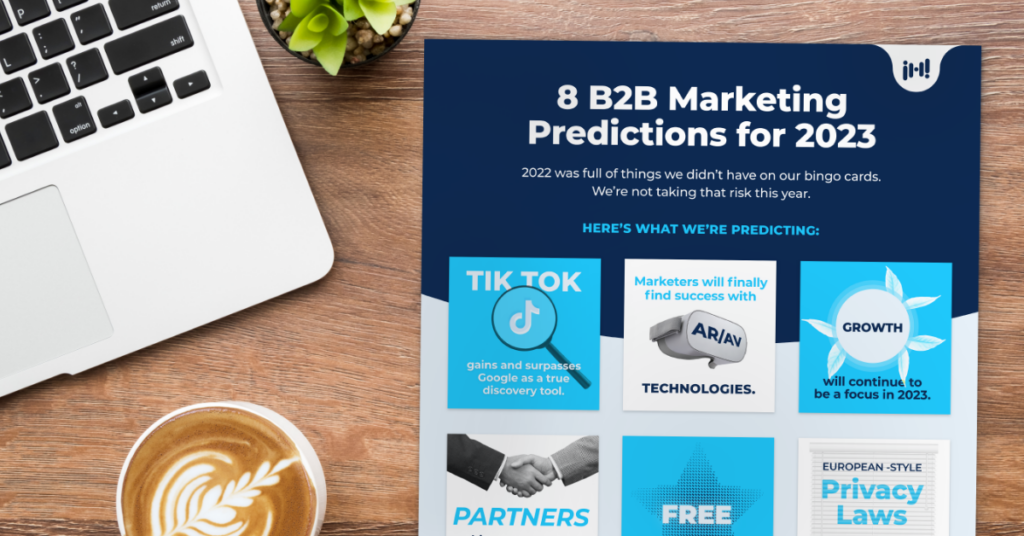Here’s the rundown on each of those predictions and why we thought they were important enough to add to our Iron Horse 2023 bingo card.
1. TikTok will gain and surpass Google as a true discovery tool.
TikTok has changed how young people discover anything.
Google is no longer their default search engine. They use TikTok to discover music, travel destinations, and even business-related content because they feel the algorithm is much better for curating content. They’re getting better information.
However, it doesn’t mean that they don’t search anymore, it’s just not their default anymore—it’s secondary. The savviest businesses are already experimenting with how to reach this audience, which now predominantly lives in that channel. We don’t think it’ll be the year for it to take over in B2B, but we believe more businesses will start creating more content for TikTok than they have in the past.
2. Marketers will finally find success with AR/AV technologies.
Just like how QR codes made a major comeback as a means for no-touch business interactions in the early days of the pandemic, we believe AR/VR will get its opportunity to shine. There have been some really good industrial B2B applications for it, which are especially effective at showing products that are hard to demonstrate traditionally to customers.
We put this one on the edge of our bingo card because it’s an optimistic prediction. We don’t fully anticipate AR/VR becoming wildly popular this year, but would be thrilled if it did! It’s more likely that we’ll see advancement in terms of niche areas, but there’s still a long way to go.
3. Growth will continue to be a focus in 2023.
Despite the announcements and news cycles that started it all off, we still expect 2023 to be a year of growth for B2B businesses.
In our recent buyer insights survey, B2B marketing and sales leaders reported more focus on growth than on cutting back, which is just the latest evidence that shows the lesson companies have learned about agility—about making sure they have the capability to be more flexible, to pivot their business strategies if required, and to quickly adapt to market conditions.
We predict momentum will start building in Q2 of 2023, with B2B enterprises having a full growth mindset in the second half of the year.
4. Partners will drive more revenue than sales as a way to drive growth.
We’re excited to see companies making headway towards not just building partner ecosystems but going to market through co-marketing and co-selling.
There’s been a huge shift towards leveraging partnerships, which companies have been using for a long time. However, they have mainly been building partner ecosystems without going to market. Most people have only been focusing on building their databases and getting more leads. However, the trend in partner marketing is shifting to true partnerships where both parties work together to serve the customer better than they could alone. A great example is HubSpot, which has truly leveraged the partner ecosystem to the point where a significant amount of their revenue—around 40% in 2020—comes through partners.
The power of partnerships is amazing and has the potential to lead to additional, stronger revenue streams if it’s harnessed properly.
5. European-style privacy laws will become the norm in the US, if not the law.
Hot take: GDPR is a good thing. And it’s going to spread. General Data Protection Regulation (GDPR) and other stricter cookie regulations give power to the end-user to control how their info is used. That’s not bad. And marketing will figure out a way to get insights. It already has.
People are willing to let companies use their info as long as it is useful to them. People just don’t want companies to abuse it. GDPR has been around for years now, and we’ve been doing it pretty successfully. All the noise around this trend is alarming many, but it’s just good housekeeping to us.
6. Salespeople will be super-charged (if senior sales lets them).
Research we conducted last year revealed that alignment between marketing and sales operations was a top priority for leaders in charge of both marketing and sales in 2023. Other sales leaders followed more of an expected trend, prioritizing growth over alignment.
This tells us that those in charge of both sides are realizing that, in order to be more effective and efficient, sales need to build their pipeline alongside marketing and pay attention to the data marketing gives them about target accounts and opportunities that are most likely to close. That way, sales can focus on doing what they do best: building relationships and closing deals.
7. AI will become an integral part of marketing operations.
We’re excited about the awesome developments happening in the AI space today, with generative AI, such as ChatGPT, as a prime example. AI now being delivered in a human-consumable format through chat interfaces, which makes it accessible to everyone, not just developers and engineers.
So many of us struggle to organize our thoughts around a particular topic, such as sending an email or researching a topic for our boss. The fact that we can have a general conversation in ChatGPT and get some level of structure, even if it’s only around 45-50% accurate, is still valuable because it saves time and provides a starting point that we can build upon.
We don’t think AI will dominate 2023 from a marketing operations perspective, but we do think you will see some awesome nuggets come out that help us do better. The key thing in 2023 is experimentation, which will help people overcome their fear of AI.
8. Marketing lead generation will matter less.
As we move into 2023, it’s becoming clear that marketing lead generation is not as important as it used to be. But hear us out.
Technically speaking, a lead is just someone who raises their hand without any context. We need to ask ourselves why they’re interested, who they are, and whether they fit into our ideal customer profile. Generating a bunch of leads without context just creates noise.
Instead, we should focus on a collaborative approach between sales and marketing to capture opportunities that are already in a buying cycle and nurture them based on market signals.
The Iron Horse insight.
It’s worth noting that many of the predictions we discussed aren’t necessarily limited to just 2023 but may continue to evolve and shape the future beyond that. Whether it’s the impact of TikTok on the younger generation, the fall of lead generation, or the increasing importance of strategic partnerships and reseller ecosystems, these trends are likely to persist and develop over time.
While it can be hard to predict exactly how they will evolve, individuals and businesses need to keep an eye on these changes and adapt accordingly to remain competitive and successful in the years to come.



